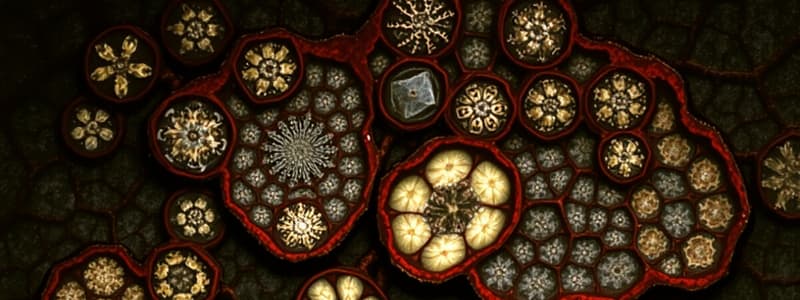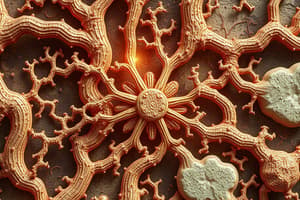Podcast
Questions and Answers
What is one of the primary functions of connective tissue?
What is one of the primary functions of connective tissue?
- Enhancing muscle contraction strength
- Providing structural support to tissues and organs (correct)
- Facilitating nerve impulses
- Regulating hormonal secretions
What is the origin of connective tissues?
What is the origin of connective tissues?
- Mesoderm (correct)
- Neuroectoderm
- Entoderm
- Ectoderm
Which type of connective tissue has a fluid or liquid ground substance?
Which type of connective tissue has a fluid or liquid ground substance?
- Skeletal or supporting connective tissue
- Connective tissue proper
- Vascular or fluid connective tissue (correct)
- Dense connective tissue
Which component of connective tissue is primarily responsible for its flexible properties?
Which component of connective tissue is primarily responsible for its flexible properties?
What type of connective tissue is primarily characterized by a gelatinous or semi-solid matrix?
What type of connective tissue is primarily characterized by a gelatinous or semi-solid matrix?
Which type of connective tissue primarily aids in defense and protection of the body?
Which type of connective tissue primarily aids in defense and protection of the body?
What type of matrix characterizes skeletal or supporting connective tissue?
What type of matrix characterizes skeletal or supporting connective tissue?
Which of the following is NOT a main component of connective tissue?
Which of the following is NOT a main component of connective tissue?
Which type of connective tissue is referred to as the ‘packing material’ of the body?
Which type of connective tissue is referred to as the ‘packing material’ of the body?
What is the role of fat storage in connective tissue?
What is the role of fat storage in connective tissue?
Flashcards
What is connective tissue?
What is connective tissue?
Connective tissues are a diverse group of tissues that connect, support, and bind other tissues in the body. They originate from the mesoderm, a germ layer in embryonic development.
What are the main functions of connective tissue?
What are the main functions of connective tissue?
- Structural Support: Provides framework and stability for organs and tissues.
- Exchange Medium: Allows nutrients, oxygen, and waste products to move between blood and cells.
- Fat Storage: Adipose tissue acts as a reservoir for energy storage.
- Defense and Protection: Contains cells that defend against infection and injury.
What are the main components of connective tissue?
What are the main components of connective tissue?
Connective tissue is made up of three main components:
What is matrix in connective tissue?
What is matrix in connective tissue?
Signup and view all the flashcards
What are the different types of fibers in connective tissue?
What are the different types of fibers in connective tissue?
Signup and view all the flashcards
What is connective tissue proper?
What is connective tissue proper?
Signup and view all the flashcards
What is vascular or fluid connective tissue?
What is vascular or fluid connective tissue?
Signup and view all the flashcards
What is skeletal or supporting connective tissue?
What is skeletal or supporting connective tissue?
Signup and view all the flashcards
What is loose connective tissue?
What is loose connective tissue?
Signup and view all the flashcards
What is areolar connective tissue?
What is areolar connective tissue?
Signup and view all the flashcards
Study Notes
Connective Tissue Overview
- Connective tissues connect, support, and bind other tissues in the body
- Originates from mesoderm
- Key functions include providing structural support, facilitating metabolic exchange, being a site for fat storage, and aiding in defense and protection.
Main Components of Connective Tissue
- Cells: A variety of cell types exist, including fibroblasts, macrophages, mast cells, and more
- Fibers: Collagen, elastin, and reticular fibers form the framework of the tissue
- Matrix (ground substance): A surrounding material that varies in consistency from semi-solid to solid or liquid, depending on the specific type of connective tissue.
Classification of Connective Tissue
- Connective Tissue Proper: Gelatinous or semi-solid ground substance (e.g., loose and dense connective tissues)
- Fluid Connective Tissue: Fluid or liquid ground substance (e.g., blood and lymph)
- Supporting Connective Tissue: Solid or rubbery ground substance (e.g., cartilage and bone)
Loose Connective Tissue (Areolar)
- Description: Gel-like matrix with all three fiber types (collagen, elastic, reticular); cells include fibroblasts, macrophages, mast cells, and white blood cells
- Function: Wraps and cushions organs, phagocytizes bacteria, plays role in inflammation, holds and conveys tissue fluid
- Location: Widely distributed beneath epithelia, forms lamina propria of mucous membranes, packages organs, surrounds capillaries
Adipose Tissue
- Description: Sparse matrix, closely packed adipocytes (fat cells) with large fat droplets displacing nucleus
- Functions: Reserve food fuel, insulation, support and protection of organs
- Location: Subcutaneous tissue, around kidneys and eyeballs, within abdomen, breasts
Reticular Connective Tissue
- Description: Network of reticular fibers in a loose ground substance with reticular cells
- Function: Forms a soft internal skeleton (stroma) supporting various cell types (e.g., white blood cells, mast cells, macrophages)
- Location: Lymphoid organs (lymph nodes, bone marrow, spleen)
Dense Connective Tissue
- Dense Regular:
- Description: Primarily parallel collagen fibers; a few elastic fibers
- Function: Attaches muscles to bones or muscles; withstands great tensile stress when pulling force is applied in one direction
- Location: Tendons, most ligaments, aponeuroses
- Dense Irregular:
- Description: Primarily irregularly arranged collagen fibers; some elastic fibers
- Function: Withstands tension exerted in many directions, provides structural strength
- Location: Fibrous capsules of organs and of joints, dermis of the skin, submucosa of digestive tract
- Elastic:
- Description: Dense regular connective tissue containing a high proportion of elastic fibers
- Function: Allows tissue to recoil after stretching, maintains pulsatile flow of blood through arteries, aids passive recoil of lungs
- Location: Walls of large arteries, within certain ligaments, walls of bronchial tubes
Studying That Suits You
Use AI to generate personalized quizzes and flashcards to suit your learning preferences.




